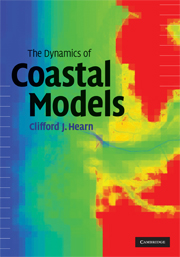Book contents
- Frontmatter
- Contents
- Preface
- Acknowledgements
- Note on mathematics and model codes
- 1 Prelude to modeling coastal basins
- 2 Currents and continuity
- 3 Box and one-dimensional models
- 4 Basic hydrodynamics
- 5 Simple hydrodynamic models
- 6 Modeling tides and long waves in coastal basins
- 7 Mixing in coastal basins
- 8 Advection of momentum
- 9 Aspects of stratification
- 10 Dynamics of partially mixed basins
- 11 Roughness in coastal basins
- 12 Wave and sediment dynamics
- References
- Index
- References
7 - Mixing in coastal basins
Published online by Cambridge University Press: 18 December 2009
- Frontmatter
- Contents
- Preface
- Acknowledgements
- Note on mathematics and model codes
- 1 Prelude to modeling coastal basins
- 2 Currents and continuity
- 3 Box and one-dimensional models
- 4 Basic hydrodynamics
- 5 Simple hydrodynamic models
- 6 Modeling tides and long waves in coastal basins
- 7 Mixing in coastal basins
- 8 Advection of momentum
- 9 Aspects of stratification
- 10 Dynamics of partially mixed basins
- 11 Roughness in coastal basins
- 12 Wave and sediment dynamics
- References
- Index
- References
Summary
Introduction
This chapter considers various aspects of mixing in coastal basins, with particular emphasis on the comparative roles of turbulence and molecular processes. Some of the applications will be pursued in more detail in later chapters, and here we mainly discuss vertical mixing processes. The key elements of mixing theory as presented in this book are Fick's law and idea of the coefficient of mixing. Our focus in this chapter is largely with mixing in unstratified basins and this forms the basis for our later understanding of the way in which stratification reduces vertical mixing. The only exception to this order of presentation is that we do briefly consider in this chapter the effects of the thermocline at the bottom of a surface wind mixed layer.
Theory of mixing
Nature of mixing
Mixing is a crucial component of the dynamics of coastal basins, and involves all quantities that are of interest in models of coastal basins such as momentum, energy, salt, heat, dissolved nutrients and chemicals (such as oxygen), organic and non-organic particulate material, and so on. There are a number of specialized terms that are used for different types of mixing. The mixing of momentum is also called friction or viscosity. The word diffusion is synonymous with mixing, and we will often use it instead of mixing. Mixing is one of the most important topics in oceanography, and plays a major role in the basic dynamics of the oceans and estuaries.
- Type
- Chapter
- Information
- The Dynamics of Coastal Models , pp. 228 - 285Publisher: Cambridge University PressPrint publication year: 2008



